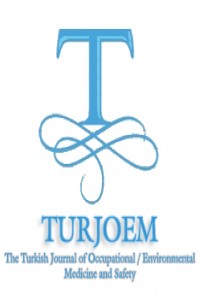METAL ANALYSIS OF NATURAL AND LABORATORY CONDITIONS AND DETERMINATION OF SOME ANTIOXIDANT ENZYME LEVELS OF ASTACUS LEPTODACTYLUS
Öz
Çomar Stream is
located in the province of Çorum and is an important wetland that provide
drinking water. There is not any study on the impact of heavy metal
contamination on stream. This work investigated the distribution of application
of Cu, As, Cd, Cr, Al, Hg, Pb, Zn, Ni, Mn and Fe in the sediment and water of
Çomar Stream and assessed heavy metal
toxicity risk with the application of different sets of Sediment Quality
Guideline (SQG) indices (contamination factor (C_f^i), contamination degree
(Cd),Modified degree of contamination (mCd), enrichment factor (EF), geoaccumulation
index (Igeo), pollution load index (PLI), potential ecological risk index
(PERI) (E_r^i), potential toxicity response index (RI), effect range median
values (m-ERM-Q), probable effect level (m-PEL-Q)). This method of evaluation
is observed as a result of Mn metal up to create ecological risks; 45.26% Ni
ratio in the metal sediment has been found to comprise a major portion
toxicity. In addition, sediment samples in the strong negative correlation
Cr-Fe (r = -,857) is between, in water samples has been determined that there
is no correlation.
Crayfish
(Astacus leptodactylus) brought from Çomar Stream were exposed to different
concentrations of cadmium (5.33; 33.3; 208 ve 1300 µg/L) during 7 days in the
laboratory. As a result, GST and GR activities significantly increased with
increasing cadmium concentration (p<0.05); LPO level were not observed any
differences (p>0.05).
Acknowledgments: This work was supported by
Ankara University [grant number 13B4240007 BAP].
Anahtar Kelimeler
Kaynakça
- Şeyda Fikirdeşici ERGEN, Sofia R. MESQUITA, Emrah ACARÖZ, Ahmet ALTINDAĞ, Turgay TEKINAY, Evren TUNCA, Laura GUIMARÃES
- Ankara University, Department of Biology, Faculty of Science, Ankara, Turkey Interdisciplinary Centre of Marine and Environmental Research (CIIMAR/CIMAR), University of Porto, Portugal Gazi University, Life Sciences Application and Research Center, Ankara, Turkey Ordu University, Faculty of Marine Sciences, Fatsa, Ordu, Turkey
Öz
Kaynakça
- Şeyda Fikirdeşici ERGEN, Sofia R. MESQUITA, Emrah ACARÖZ, Ahmet ALTINDAĞ, Turgay TEKINAY, Evren TUNCA, Laura GUIMARÃES
- Ankara University, Department of Biology, Faculty of Science, Ankara, Turkey Interdisciplinary Centre of Marine and Environmental Research (CIIMAR/CIMAR), University of Porto, Portugal Gazi University, Life Sciences Application and Research Center, Ankara, Turkey Ordu University, Faculty of Marine Sciences, Fatsa, Ordu, Turkey
Ayrıntılar
| Bölüm | Articles |
|---|---|
| Yazarlar | |
| Yayımlanma Tarihi | 16 Şubat 2017 |
| Yayımlandığı Sayı | Yıl 2017 Cilt: Volume 2 Sayı: İssue 1 (1) - 2.İnternational Congress Of Forensic Toxicology |


